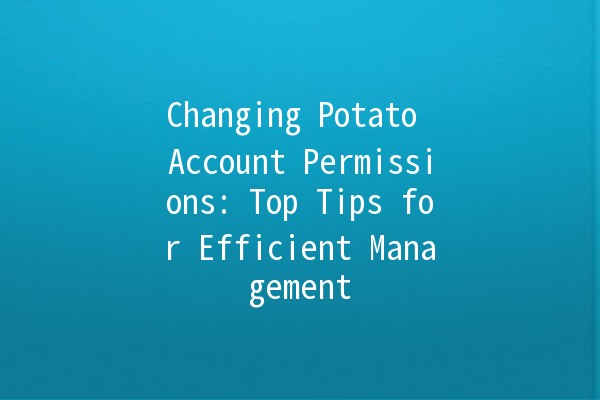Managing account permissions is crucial in today's digital landscape, especially when it comes to applications like Potato, a versatile platform for various services. Whether you're an admin, a developer, or a casual user, understanding how to efficiently change account permissions can significantly enhance productivity and security. In this article, we will explore practical tips on managing Potato account permissions, ensuring that you have the best practices at your fingertips.
Understanding Potato Account Permissions
What are Account Permissions?
Account permissions define what users can or cannot do within a platform. They often dictate access levels to data, features, and functionalities of the Potato application. Permission levels typically include:

Admin: Full control over settings and user management.
Editor: Ability to create and modify content but limited in settings access.
Viewer: Readonly access to information without modification capabilities.
Why are Permissions Important?
Properly managing permissions is essential for:
Data Security: Limiting access to sensitive information.
Operational Efficiency: Ensuring that users only have access to necessary tools.
Collaboration: Facilitating a smooth workflow among team members.
Boosting Productivity with Permission Changes
Here are five actionable tips to enhance productivity through efficient permission management in Potato:
It’s vital to periodically evaluate the needs of your team. As projects evolve, so do the requirements for access.
Application Example: Conduct biannual reviews to discuss and adjust permissions based on current projects or tasks.
Instead of granting permissions individually, leverage rolebased access control to streamline the process.
Application Example: Assign roles such as ‘Marketing Team’ or ‘Development Team’ to multiple users to ensure they have the necessary permissions without manually adjusting each account.
For projectbased tasks, granting temporary permissions can be more secure than permanent access.
Application Example: For a new marketing campaign, give the marketing team editorlevel access for the duration of the project, then revert their permissions afterward.
Maintaining a log of permission changes helps in tracking who has access to what and when changes were made.
Application Example: Use a shared document to record all permission changes, including the reasons for these changes, to ensure accountability and provide an audit trail.
Providing training sessions on how to properly manage permissions can alleviate many potential issues.
Application Example: Schedule a monthly training for your team members on the importance of permissions and how to request changes appropriately.
Common Questions About Potato Account Permissions
While granting broader access may seem beneficial, it can lead to unintended changes or security risks. It's crucial to align permissions with the user's role to maintain data integrity and security.
Yes, revoking permissions is straightforward in Potato. Navigate to the user management section, select the user, and adjust their permission settings to restrict access as necessary.
To keep track of users with access to sensitive data, regularly run permission audits. This review process involves examining roles and permissions assigned to each user and adjusting them based on current needs.
Potato allows users to create multiple roles, but the exact limit may depend on your subscription plan. Review your plan’s specifications to understand any restrictions.
It’s advisable to review permissions at least twice a year or whenever there is a significant change in the team or projects.
If a user encounters access issues, first confirm their assigned permissions. If they need more access, evaluate their request against their role and project requirements before making changes.
Implementing Permission Changes: Best Practices
Establish a Clear Permission Structure
Define a clear hierarchy of permissions that aligns with your organization’s structure and operational needs. For instance, make it clear who can assign roles and who can change sensitive settings.
Encourage Feedback
Foster an environment where team members feel comfortable voicing concerns regarding their permissions. This feedback loop can help optimize teamwork and efficiency.
Monitor and Adjust
Keep an eye on how permission changes affect workflow. Be prepared to make adjustments based on realworld usage and feedback.
Utilize Software Tools
Consider using software tools that offer analytics on permission usage. This can help you identify potential security risks or when users might be struggling with their access levels.
Communicate Changes Effectively
Whenever you make changes to permissions, ensure that users are informed. Clear communication will help avoid confusion and improve user experience.
Managing Potato account permissions doesn’t have to be a daunting task. By implementing these strategies, you can enhance security, streamline operations, and foster a collaborative environment. Remember to stay proactive in your approach, ensuring that permissions evolve alongside your team and projects for optimum results.
This article should provide you with a comprehensive understanding of how to effectively manage Potato account permissions, allowing you to maximize efficiency and security in your work environment.